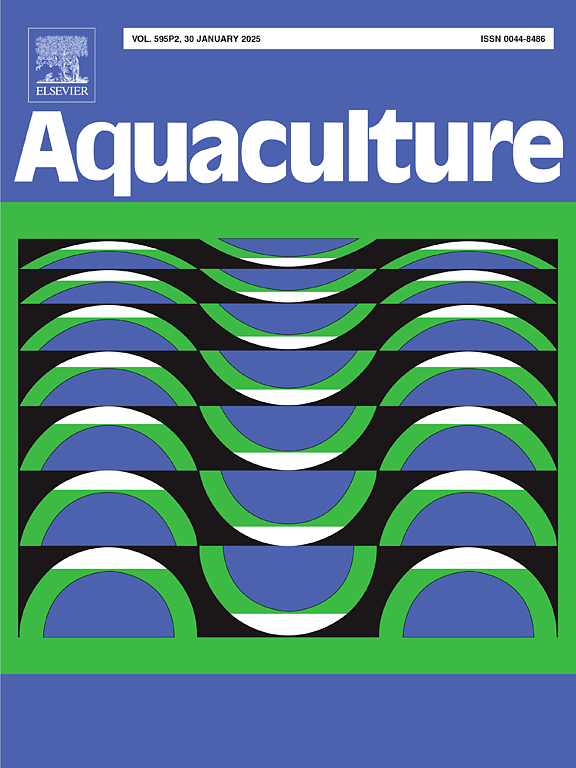Evaluation of the psychrotrophic marine yeast Yarrowia bubula as potential feed for Artemia salina
IF 3.9
1区 农林科学
Q1 FISHERIES
引用次数: 0
Abstract
Aquaculture is a rapidly growing food producing sector that is vulnerable to disease outbreaks. Since persistent application of antibiotics is associated with certain drawbacks, current focus on enhancing performance of aquaculture species is via use of environment-friendly nutritional supplementations, probiotic preparations and immunostimulants. Microorganisms belonging to ‘Generally Regarded as Safe’ category capable of utilizing low-cost substrates, containing high protein contents and exhibiting desirable fatty acid profiles are important in this regard. In current study, a psychrotrophic marine yeast Yarrowia bubula capable of growing on waste cooking oil (WCO), whey and raw glycerol was assessed for its potential as aquaculture feed. When concentrations of substrates were varied individually, maximum biomass was obtained when WCO, whey and glycerol were provided at 1.5, 50 and 1 % levels, respectively. Effect of the obtained biomass on the crustacean model system Artemia salina was studied with respect to its growth, survival and resistance towards aquaculture pathogens. Biomass of Saccharomyces cerevisiae and Y. bubula grown on glucose were considered as ‘control’ samples (C1 and C2, respectively). While, Y. bubula cultivated on WCO (F1), whey (F2) and glycerol (F3) were the ‘test’ feed samples. Crustaceans fed with F3 samples were bigger in size and exhibited well-developed appendages. Moreover, A. salina groups fed with F3 and F1 feeds displayed better survival of 88.89 ± 7.70 and 79.99 ± 11.55 %, respectively. Compared to other diets, specimens fed with these two diets showed enhanced resistance towards Vibrio harveyi (F3: 44.44 ± 10.18 % and F1: 39.99 ± 6.67 %) and Pseudomonas aeruginosa (F3: 68.88 ± 3.85 % and F1: 62.22 ± 3.85 %). There was upregulation of hsp70, tgase and proPO mRNA levels in groups of larvae fed with Y. bubula diets C2, F1, F2 and F3, compared to those fed with S. cerevisiae C1, suggestive of the former biomass being instrumental in enhancing immunity. Pearson correlation analysis indicated that total protein, lipid contents and fatty acid compositions of Y. bubula were key factors contributing towards increased survival, disease resistance and expression of immune related genes (hsp70 and proPO) in A. salina. This study is the first report that shows the potential of Y. bubula capable of growing on low-cost substrates in improving survival, overall health and immune responses in aquaculture species.

水产养殖是一个快速发展的食品生产行业,很容易爆发疾病。由于持续应用抗生素存在一定的弊端,目前提高水产养殖物种性能的重点是使用环境友好型营养补充剂、益生菌制剂和免疫刺激剂。在这方面,属于 "公认安全 "类别的微生物非常重要,它们能够利用低成本底物,蛋白质含量高,并表现出理想的脂肪酸谱。在目前的研究中,对一种能在废弃食用油(WCO)、乳清和未加工甘油上生长的海洋酵母菌 Yarrowia bubula 进行了评估,以确定其作为水产养殖饲料的潜力。当基质的浓度各不相同时,当 WCO、乳清和甘油的含量分别为 1.5%、50% 和 1%时,生物量最大。研究了获得的生物量对甲壳类模型系统盐鲫的生长、存活和对水产养殖病原体的抵抗力的影响。在葡萄糖上生长的酿酒酵母和小酵母的生物量被视为 "对照 "样本(分别为 C1 和 C2)。而用 WCO(F1)、乳清(F2)和甘油(F3)培养的小蠊则是 "测试 "饲料样本。用 F3 样品喂养的甲壳动物体型更大,附肢发达。此外,用 F3 和 F1 饲料喂养的 A. salina 组的存活率较高,分别为 88.89 ± 7.70 % 和 79.99 ± 11.55 %。与其他饲料相比,喂食这两种饲料的标本对哈维弧菌(F3:44.44 ± 10.18 %,F1:39.99 ± 6.67 %)和铜绿假单胞菌(F3:68.88 ± 3.85 %,F1:62.22 ± 3.85 %)的抵抗力更强。与饲喂 S. cerevisiae C1 的幼虫相比,饲喂 Y. bubula 日粮 C2、F1、F2 和 F3 的幼虫组 hsp70、tgase 和 proPO mRNA 水平上调,表明前者的生物量有助于提高免疫力。Pearson 相关性分析表明,Y. bubula 的总蛋白、脂质含量和脂肪酸组成是提高盐田蛙存活率、抗病性和免疫相关基因(hsp70 和 proPO)表达的关键因素。这项研究是首次报道能在低成本底质上生长的小疣梭子蟹在提高水产养殖物种的存活率、整体健康和免疫反应方面的潜力。
本文章由计算机程序翻译,如有差异,请以英文原文为准。
求助全文
约1分钟内获得全文
求助全文
来源期刊

Aquaculture
农林科学-海洋与淡水生物学
CiteScore
8.60
自引率
17.80%
发文量
1246
审稿时长
56 days
期刊介绍:
Aquaculture is an international journal for the exploration, improvement and management of all freshwater and marine food resources. It publishes novel and innovative research of world-wide interest on farming of aquatic organisms, which includes finfish, mollusks, crustaceans and aquatic plants for human consumption. Research on ornamentals is not a focus of the Journal. Aquaculture only publishes papers with a clear relevance to improving aquaculture practices or a potential application.
 求助内容:
求助内容: 应助结果提醒方式:
应助结果提醒方式:


